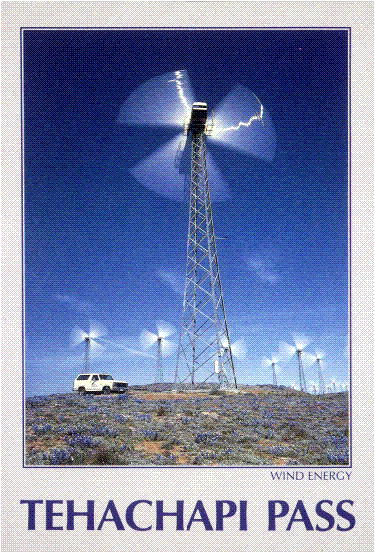Wind Power at Tehachapi
and Altamont Pass
Efforts to incorporate and expand wind power as a renewable
source of electrical energy began in earnest in the 1970's. Federal tax
credits offered incentives to pursue research and development in the area
of alternate energy sources when fossil fuels began to prove unreliable.
Though that energy crisis passed, the resultant wind farms, such as that
at Tehachapi, remain. These wind power production facilities continue to
expand, encouraged by continuing tax credits and renewable energy programs.
 According
to the Tehachapi
Chamber of Commerce, Enron's
Victory Garden Wind Power Facility in the Tehachapi-Mojave Wind Resource
Area became the number one producer of wind energy in the world in 1993.
This facility uses almost 5,000 wind turbines in one of the windiest areas
in the world. Wind speeds through Tehachapi Pass average 14-20 mph, at
times producing gale force winds for days on ends. The turbines turn themselves
on and off in response to wind conditions, and can rotate to intercept
the wind when it changes direction. The electricity generated is sold to
Southern California Edison for distribution, mainly in the Antelope Valley.
Yearly production ranges from 1.0-1.3 billion kWh of electricity each year,
enough to support the lifestyles of 500,000 southern Californians, or one
million Europeans.
According
to the Tehachapi
Chamber of Commerce, Enron's
Victory Garden Wind Power Facility in the Tehachapi-Mojave Wind Resource
Area became the number one producer of wind energy in the world in 1993.
This facility uses almost 5,000 wind turbines in one of the windiest areas
in the world. Wind speeds through Tehachapi Pass average 14-20 mph, at
times producing gale force winds for days on ends. The turbines turn themselves
on and off in response to wind conditions, and can rotate to intercept
the wind when it changes direction. The electricity generated is sold to
Southern California Edison for distribution, mainly in the Antelope Valley.
Yearly production ranges from 1.0-1.3 billion kWh of electricity each year,
enough to support the lifestyles of 500,000 southern Californians, or one
million Europeans.
In contrast to the facility at Tehachapi, Altamont Pass
boasts over 5,000 wind turbines. Yet Altamont Pass generates less electricity,
averaging slightly less than 1.0 billion kWh of electricity each year.
We can clearly see that wind power is a viable source
of energy. What, however, are the specific benefits
and drawbacks associated with wind
power? http://rotor.fb12.tu-berlin.de/windfarm/tehpost.html
 According
to the Tehachapi
Chamber of Commerce, Enron's
Victory Garden Wind Power Facility in the Tehachapi-Mojave Wind Resource
Area became the number one producer of wind energy in the world in 1993.
This facility uses almost 5,000 wind turbines in one of the windiest areas
in the world. Wind speeds through Tehachapi Pass average 14-20 mph, at
times producing gale force winds for days on ends. The turbines turn themselves
on and off in response to wind conditions, and can rotate to intercept
the wind when it changes direction. The electricity generated is sold to
Southern California Edison for distribution, mainly in the Antelope Valley.
Yearly production ranges from 1.0-1.3 billion kWh of electricity each year,
enough to support the lifestyles of 500,000 southern Californians, or one
million Europeans.
According
to the Tehachapi
Chamber of Commerce, Enron's
Victory Garden Wind Power Facility in the Tehachapi-Mojave Wind Resource
Area became the number one producer of wind energy in the world in 1993.
This facility uses almost 5,000 wind turbines in one of the windiest areas
in the world. Wind speeds through Tehachapi Pass average 14-20 mph, at
times producing gale force winds for days on ends. The turbines turn themselves
on and off in response to wind conditions, and can rotate to intercept
the wind when it changes direction. The electricity generated is sold to
Southern California Edison for distribution, mainly in the Antelope Valley.
Yearly production ranges from 1.0-1.3 billion kWh of electricity each year,
enough to support the lifestyles of 500,000 southern Californians, or one
million Europeans.